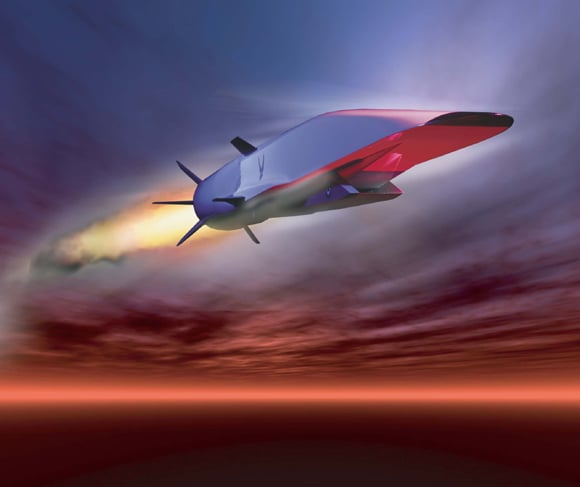Original URL: https://www.theregister.com/2010/05/27/x51_first_shot/
X-51 hypersonic scramjet test: Flameout at Mach 5?
Boffins still 'ecstatic' after 3-minute strato-streak
Posted in Science, 27th May 2010 10:21 GMT
US government aerospace agencies have achieved the world's first hypersonic scramjet flight using hydrocarbon fuel. The test did not go perfectly, but further flights will follow; organisers said they were "ecstatic" with progress thus far.

Shockwave riding supersonic-combustion-ramjet hypersonic hotness.
The X-51A "Waverider" craft was dropped from a modified B-52 bomber test mothership 50,000 feet above Point Mugu sea firing range off the California coast at about 6pm last night UK time (10am local). Four seconds later a rocket booster taken from a tactical missile fired, accelerating the Waverider to Mach 4.5 before being jettisoned. The airframe doesn't work like a normal aeroplane: it actually surfs on the sonic shockwaves trailing back from its nose, hence its name.
The hypersonic X-51A ignited, burning a mixture of ethylene and JP-7 jet fuel, and once well alight switched over to all-jetfuel operation. Normal turbojets can't operate at hypersonic speeds; the Waverider is a ramjet, whose intake air is simply scooped in at the front due to its speed rather than being crammed in by compressor blades.
But normal ramjets have to slow that air down to subsonic speed inside themselves so as to avoid blowing out the flame in their combustion chamber. This limits them to a top speed of perhaps Mach 3.5. The Waverider, though, is a scramjet - a supersonic combustion ramjet - which lets the air blow through it supersonically. It is thought by its designers to be capable of burning for 300 seconds to reach Mach 6.
The X-51A didn't fulfil that potential yesterday, however. Having lit up it burned for around 200 seconds, reaching approximately Mach 5 and climbing to 70,000 feet. According to a statement issued by Boeing (whose Phantom Works plant built the Waverider):
Something then occurred that caused the vehicle to lose acceleration. At that point, the X-51A was terminated as planned.
It's possible to speculate that the flame in the Waverider's SJY61 scramjet, built by Pratt & Whitney Rocketdyne, simply blew out. Project officials are still happy with the test, and seem confident that they will be able to achieve the designed speed before running out of test craft - there are three more.
"We are ecstatic to have accomplished most of our test points on the X-51A's very first hypersonic mission," said Charlie Brink, X-51A honcho at the US Air Force Research Laboratory.
"No test is perfect," he added. "But anyone will tell you that we learn just as much, if not more, when we encounter a glitch."
If they can sort it, we may see Son of Blackbird (SR-71) return
The test is significant aerospace news, as it is the first hypersonic flight by a hydrocarbon-fuelled scramjet as opposed to one running on hydrogen. Hydrogen scramjets have achieved Mach 10, but they are less likely to develop into practical aerospace craft as hydrogen is bulky and difficult to store in large quantities. Any hydrogen-fuelled aircraft, missile etc would be almost entirely fuel tank.
The technologies in the Waverider, however, might see the appearance of hypersonic missiles in the near future, able to travel huge distances quickly and close in on their targets so fast they would be almost impossible to defend against.
In the longer term, those involved in the X-51A hope that it might give birth to new and impressive aerospace craft. Brink, for instance, has speculated in the past that it might be possible to get the scramjet to fire up initially at speeds low enough to be reached by regular afterburning turbojets rather than booster rockets.
This would open up the prospect of a plane able to take off from a runway and accelerate to scramjet ignition speed using jets, then switch into scramjet mode and surge forward into the hypersonic regime. This would essentially be a modern, hypersonic update of the legendary SR-71 Cold War turbo/ramjet spyplane, the famous Mach-3.5 "Blackbird".
Military crazytech agency DARPA (partnered with the airforce lab on X-51A) tried to get funding for such a super-Blackbird - dubbed "Blackswift" - a couple of years back but sceptical Washington politicos refused to fund it, doubting that it could be built. Success for the Waverider might revive such ideas, however.
Mach 6 hypersonic turbo/scramjets running on regular jet fuel would be impressive enough. They might also serve in turn as stepping stones to still greater things.
Turbo/scram craft might be still further enhanced by the addition of a rocket mode. They would be able to take off from a runway, gain a lot of speed and height still burning air, and then make the final climb and acceleration to Mach-25 orbital velocity as rockets. The fact that they would need to carry significantly less oxidiser than conventional launch rockets might mean that they could get into space with a useful payload and not need to throw large parts of themselves away in the process; nor would there be the expense and trouble of pointing them vertically into the sky for launch as with today's space shuttles.
"This is a new world record," enthused Joe Vogel of Boeing, speaking of yesterday's X-51A flight. "[It] sets the foundation for several hypersonic applications, including access to space, reconnaissance, strike, global reach and commercial transportation."
It's probably a bit early to say most of that, but it will certainly be very interesting to see how the rest of the X-51A tests turn out. Scramjet enthusiasts may want to watch the recent vid on the Waverider below, offered by the Hypersonic Combined Test Force at Edwards airforce base. ®